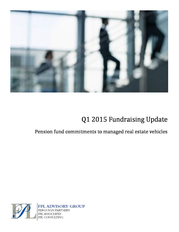Description
Market View
(continued from page 15)
within the public real estate marketplace increased by 10 percent across the executive
team, in aggregate. The median level of CEO
pay was approximately $4.8 million, with approximately 15 percent comprising base salary and the remaining 85 percent in the form
of incentives—both cash and equity. Other
key executives—including COO, CFO and
general counsel—had median pay levels of
$2.4 million, $1.8 million and $1.3 million,
respectively. Not only did company performance increase across years but the median
size of companies within the top 100 largest
REITs also increased substantially, from $4.9
billion in 2013 to $6.5 billion in 2014.
Comings and Goings
Separate from the levels of pay observed,
perhaps an interesting finding is the amount
18
July 2015 | Commercial Property Executive
of executive turnover across the top 100
public REITs.
Across all publicly disclosed executives within the study, there was a 7 percent turnover rate, which marks the highest level since the financial crisis in 2008. Twenty-eight percent of companies had at least one executive change between 2013 and 2014. Based on a closer examination of these shifts, there seem to be multiple reasons for executive change, including retirement, departure for “person- al reasons” (which often can be tied to a termination without cause), changes in an executive team following the hire of a new CEO, and departures from one company to go to another. Finally, public REITs fared well during the 2015 proxy season, in which only one public REIT failed the “Say-on-Pay” vote (a significant reduction from the five REITs that failed the year prior).
Highly influential proxy advisory firm Institutional Shareholder Services (ISS) strongly supported compensation proposals relating to Say-on-Pay, in which 2015 marked the lowest amount of “against” vote recommendations since it was instituted. The private sector, which is immune to public investor scrutiny and disclosures, also experienced new-high pay levels across key executive roles. Larger firms in the real estate investment management and private equity sectors continue to raise disproportionate (outsize) amounts of capital, which has an impact on annual fee income and bonus pools. Smaller shops have been very successful as long as they have a solid track record and distinguished strategy.
The midsize firms, generally speaking, are the ones that face some challenges, and compensation payouts have not maintained the same pace, although they are still healthy, historically speaking. Separately, debtfocused or originations platforms have performed very well, with the highest volume and profits observed since the market downturn. Both factors contributed to hefty bonus payouts. Retention has been a central theme over the past couple of years, as real estate has performed well. With record inflows and capital raising, there has been a need for transaction-oriented professionals to put money to work. Companies are also looking to the next generation as part of both their retention and succession planning strategies.
But a firm’s history, reputation, growth strategy and career opportunity will often overcome the financial rewards. To remain competitive, retain existing talent, and attract from the outside, companies should revisit their total rewards strategy, in which pay is just one of many elements. —Jeremy Banoff is senior managing director for FPL Associates L.P. Image by sax/iStockphoto.com TrendTalk .
Across all publicly disclosed executives within the study, there was a 7 percent turnover rate, which marks the highest level since the financial crisis in 2008. Twenty-eight percent of companies had at least one executive change between 2013 and 2014. Based on a closer examination of these shifts, there seem to be multiple reasons for executive change, including retirement, departure for “person- al reasons” (which often can be tied to a termination without cause), changes in an executive team following the hire of a new CEO, and departures from one company to go to another. Finally, public REITs fared well during the 2015 proxy season, in which only one public REIT failed the “Say-on-Pay” vote (a significant reduction from the five REITs that failed the year prior).
Highly influential proxy advisory firm Institutional Shareholder Services (ISS) strongly supported compensation proposals relating to Say-on-Pay, in which 2015 marked the lowest amount of “against” vote recommendations since it was instituted. The private sector, which is immune to public investor scrutiny and disclosures, also experienced new-high pay levels across key executive roles. Larger firms in the real estate investment management and private equity sectors continue to raise disproportionate (outsize) amounts of capital, which has an impact on annual fee income and bonus pools. Smaller shops have been very successful as long as they have a solid track record and distinguished strategy.
The midsize firms, generally speaking, are the ones that face some challenges, and compensation payouts have not maintained the same pace, although they are still healthy, historically speaking. Separately, debtfocused or originations platforms have performed very well, with the highest volume and profits observed since the market downturn. Both factors contributed to hefty bonus payouts. Retention has been a central theme over the past couple of years, as real estate has performed well. With record inflows and capital raising, there has been a need for transaction-oriented professionals to put money to work. Companies are also looking to the next generation as part of both their retention and succession planning strategies.
But a firm’s history, reputation, growth strategy and career opportunity will often overcome the financial rewards. To remain competitive, retain existing talent, and attract from the outside, companies should revisit their total rewards strategy, in which pay is just one of many elements. —Jeremy Banoff is senior managing director for FPL Associates L.P. Image by sax/iStockphoto.com TrendTalk .
Financial Markets Presentations
+
Financial Markets Sub Categories














